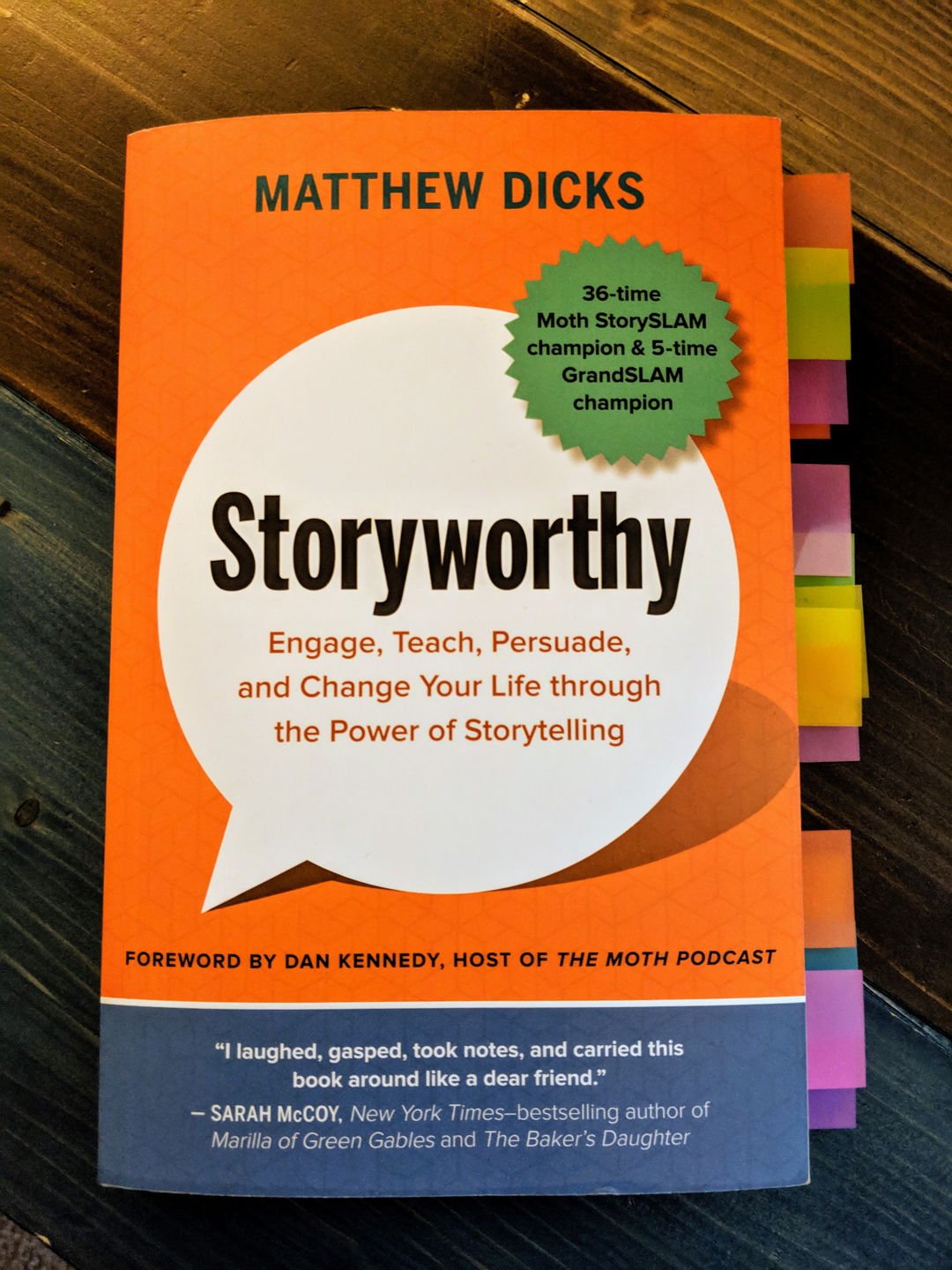Table of Contents
Identify Action Items While Taking Notes
Make Work Easier
- Identify action items throughout your notes with a large circle (e.g., O Action Item) or square (e.g., [] Action Item)
- I prefer circle. It’s faster to draw than a square.
- Once done, all of your tasks will stand out!
- Great for meeting
Here’s a photo of my notes:

- You can see my O flags stand out!
- You’ll notice that I have a couple of other symbols. This is because I’ve already processed these notes.
- Colored in (Escape the Room) is complete
- Empty ( Idea: Tech workshop) is incomplete
- Got a > symbol (Send follow-up) has been migrated to my task list
You Can Learn to Tell Amazing Stories with These 13 Tips
Make Life Easier
Storyworthy by Matthew Dicks

This book is absolutely amazing! It’s vaulted past dozens of other books to land in my top 5 favorite ever!
The author is Matthew Dicks: He’s a 36-time Moth StorySLAM champion, and a 5-time GrandSLAM champion. He knows how to tell a story.
Here’s a synopsis of the book from Amazon:
Whether we realize it or not, we are always telling stories. On a first date or job interview, at a sales presentation or therapy appointment, with family or friends, we are constantly narrating events and interpreting emotions and actions.
In this compelling book, storyteller extraordinaire Matthew Dicks presents wonderfully straightforward and engaging tips and techniques for constructing, telling, and polishing stories that will hold the attention of your audience (no matter how big or small).
He shows that anyone can learn to be an appealing storyteller, that everyone has something “storyworthy” to express, and, perhaps most important, that the act of creating and telling a tale is a powerful way of understanding and enhancing your own life.
Grab a copy
If you want to grab a copy for yourself, you can by clicking here!
Part 1: Find Your Story
If you want to learn to tell amazing stories, here’s where to start!
These first few tips are about finding your story.
1. Anyone can tell stories
You don’t have to have huge, life-changing, death-defying moments. The best stories come from small, relatable moments.
2. Does it pass the dinner test?
If you wouldn’t tell your story at a dinner party, it’s not a good story.
Also, two types of stories to avoid:
- Vacation stories: Does anyone really care?
- Drinking stories: Also, does anyone really care?
3. Do Homework for Life
Make a daily habit out of recording what’s storyworthy about the day before.
In my case, I jot down a few memories about yesterday in a spreadsheet after I wake up each morning.
4. Try Crash & Burn
This is a stream-of-consciousness writing technique that can help you generate stories.
Here are the rules:
Don’t do the following:
- Get attached to any one idea
- Judge any thought or idea that appears in your mind
- Allow the pen to stop writing
Set a timer (often 10 minutes). Ready, set, write.
5. Also try First, Last, Best, Worst
This is another story-generating exercise. You create a grid: prompts on the left; the words first, last, best, and worst along the top.
Here’s an example:
| First | Last | Best | Worst | |
| Brother | ||||
| Kiss | ||||
| Car | ||||
| Pet |
Then, go through and fill in the boxes with memories that fit those prompts.
For example, my first pet was my cat Louie. He’s also my last pet (I still have him). My best memory is him snuggled up on my lap while I drank coffee and read. The worst was jolting awake to the sound of him knocking a glass of water on my laptop
Part 2: Craft Your Story
Part 2 is about how to craft the stories you uncover.
6. Find the five-second moment
This one is easiest to just quote from the book:
All great stories — regardless of length or depth or tone — tell the story of a five-second moment in a person’s life.
These five-second moments are the moments in your life when something fundamentally changes forever.
Examples include:
- Fall in love
- Fall out of love
- Discover something new about yourself or another person
- Your opinion on a subject dramatically changes
- Find forgiveness
- Reach acceptance
- Sink into despair
- Grudgingly resign
- You’re drowned in regret
- Make a life-altering decision
- Choose a new path
- Accomplish something great
- Fail spectacularly
7. The beginning of your story is the opposite of your five-second moment
Because the five-second moment is about a fundamental change, the opposite of that change is where your story should begin.
8. Speak your story aloud
This technique works if you struggle to uncover the five-second moments in your story ideas. It also works for finding the beginnings as well.
Simply tell your story out loud, to yourself. Don’t edit or judge. Just tell the story.
This really helped me develop the story I tell in the episode!
9. Your stories should always be from your perspective
Stories should be about you. Or, if they focus on someone else, they should be about your take on those events.
10. Your stories must be about exactly one thing
You can’t have more than one five-second moment in your story.
Also, you can’t have less than one five-second moment in your story.
You should have exactly one!
11. Open your story with story
Ever notice that lots of movies start with motion? Something like a shot zooming into a city skyline. Or of folks walking.
Filmmakers start their stories with forward motion. They don’t make announcements at the beginning.
Your story should be the same way.
- DON’T: This is going to be a hilarious story.
- DO: I was sitting in a cafe, staring at the most beautiful person I’d ever seen.
- DON’T: This is a story about the time I went to the doctor.
- DO: I’m in my red Ford Fusion, cruising up I-75 in Detroit.
12. Always provide a physical location
If your audience loses a sense of where the action is taking place, it pulls them right out of your story.
Keep them grounded by making sure that you always provide a physical location. See both DO examples in #11 above.
13. Big stories are about small moments
You don’t have to have huge moments to tell great stories.
But, sometimes those moments are huge. For Matthew Dicks, he talks about his times being revived from the dead on the side of the road, getting robbed at gunpoint, and getting charged with a crime he didn’t commit.
While those might seem like great stories in and of themselves, they’re actually not. They’re not at all relateable.
So, to tell a big story, you need to find the small moments within.
Get the book!
If you want to grab a copy for yourself, you can by clicking here!
Trust me, this book is worth every penny.
Listen to My Story
I fight an inner battle while crossing the bridge from Detroit to Windsor for a late-night meetup.
You can find my story in the episode at 26:30.
Get the Free Download!
15 Strategies for Getting More Done in a Day
I have a fantastic freebie I'd love to send to you. It's a one-page guide that covers my favorite 15 strategies for making the most out of every day.
Click below to grab this download now!



